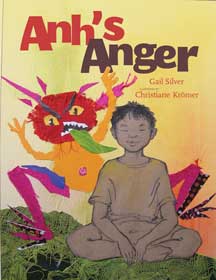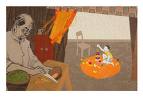By Phoebe Vreeland, The Children’s Book Review
Published: September 27, 2010

Gail Silver is the author of the award-winning children’s book, Anh’s Anger, and contributing writer to The Expectant Mother’s Guide. She is the recipient of a 2007 Parents Choice Foundation award for the Cd, A Peaceful Place Inside, and recipient of the 2004 Parents Express enterprising Woman of the year award. The Yoga Child Children’s program is a two-time Best of Philadelphia award winner, providing yoga instruction to over 30 schools in the Philadelphia area.
Phoebe Vreeland: Why did you choose to write about anger?
Gail Silver: This story was written during the year of 2006 while I nursed our third child, Chelsea Lane. These peaceful, frequent sittings provided the space for me to express on my laptop this story that had been growing inside of me for many years.
When our second child, Anabel, born in 2001, turned three she became quite versed at having long and exhausting temper tantrums. These took my husband and me by surprise because we had not experienced them with our first child, Ben. As we worked through this challenging period with Anabel, it became essential for me to examine my own relationship with anger, both as an adult and as a child. Without subjecting you to years of reflection, psychotherapy and Buddhist Philosophy I can summarize by sharing that I discovered three tenets which I had not practiced in my childhood but would come to practice in my adult relationship with anger.
1)It is okay to feel angry
2)Anger will come and given the proper attention, it will go.
3)Verbally expressing anger in a way that is not emotionally or physically hurtful to yourself nor emotionally or physically hurtful to the person to whom you are speaking is an essential part of anger resolution.
Once able to accept and honor these three tenets I became more comfortable and more skilled at managing my own anger and helping my daughter to work through hers.
This [sic] inspired me to write a story which would teach children how to mindfully manage their anger from a young age. Children have an easier time appreciating a conceptual lesson if it can be depicted with something they can see, can like, and can easily recall. When angry, we can feel monster like, so depicting the emotion as a monster like version of the main character became the chosen path for this story.
 PV: While there are other books for children that deal with anger, they
appear to be aimed at elementary school children. What age is Anh’s
Anger written for?
PV: While there are other books for children that deal with anger, they
appear to be aimed at elementary school children. What age is Anh’s
Anger written for?
GS: It is truly a book for all ages. You can begin reading this to a child as young as 2, especially with an older sibling present. It can be enjoyed by children as old as 10, and I have been told by many adults that it speaks directly to them as well.
The message of this book will be most easily appreciated if children see the practice in action in their own home. For instance, if you as an adult find yourself feeling angry, take a moment to sit with your anger. Your children are then more likely to want to do the same. My youngest child, now 4, was raised on this book and often when she is angry or in tears over something she leaves us all in the dust and climbs up the steps to our second floor “breathing room” where she spends time with her anger. As she runs away, she usually sobs, “I’m so angry, I’m going to the breathing room.”
PV: Having watched my daughter express her emotion at times I feel that children DO “play” with their emotions. For example, indulging in their tears or anger to see how it feels. Can you explain what happens on the page where Anh plays with his anger—what is going on there? Is this different than a tantrum?
GS: This is a very important question and one that I asked myself during the writing and editing phases of this book. As you noted in your review, Anh’s Anger is based upon the teachings of Thich Nhat Hanh, but a careful look at Thich Nhat Hanh’s teachings will show you that a physical outlet for anger is not suggested.
This page of Anh’s Anger provides permission for those who need a physical outlet to have one, but I am hesitant to say that it is the same as a tantrum.
Most children will come to this book at a time in their life when they have already established an automated response to anger. To ask them to immediately let go of everything comfortable and to simply become aware of their anger and to sit and breathe like Anh is a tall request. However, I do think that over time, it is realistic to expect that some children may begin to bypass the need for the physical expression of what they are feeling.
 The descriptions that I used are based on the teachings in the Yoga Child curriculum. They aim to help a child maintain an awareness or inclusion of the breath, (ie., the howling wind) as well as a rhythmic and repetitive movement of the body. (ie., playing drums on the earth with an open palm.) It can be cathartic, comforting and grounding to move our bodies in this way and also helpful in preparing us for stillness.
The descriptions that I used are based on the teachings in the Yoga Child curriculum. They aim to help a child maintain an awareness or inclusion of the breath, (ie., the howling wind) as well as a rhythmic and repetitive movement of the body. (ie., playing drums on the earth with an open palm.) It can be cathartic, comforting and grounding to move our bodies in this way and also helpful in preparing us for stillness.
If you have ever taken a yoga class, you may have found your body and mind more ready to be still for savasana after you had finished your asana practice. These movements were thoughtfully placed in the story to help ready some children for sitting, yet some may not necessarily need this piece to sit and breathe with their anger. Each of us is wired differently and each experience is different, adult to adult, child to child, day to day, and moment to moment.
PV: Was it your choice to make Anh Vietnamese or the illustrator’s and why?
GS: It was my choice and was done in recognition of Thich Nhat Hanh.
PV: You received the Skipping Stones Magazine award for 2010 Multicultural and International Awareness Books. What does this mean to you?
GS: It means more to me than I know how to express. I was probably just about as excited as a movie star is when he or she wins an Oscar, and I had never even heard about Skipping Stones until my publisher told me they were going to submit Anh’s Anger for consideration. I think I cried when I received the news. But then again, I also cried when I found out Anh’s Anger was going to be published. I guess I am a sucker for recognition.
When you write something and submit it for publication, you obviously are proud of your work and hope that others feel the same way. When a publisher decides the book to be worthy of publication, you know that at least a few people dig your story. When your little story receives such an honorable award, you sort of say, “Wow! I thought it was good, but I really wasn’t sure. I’m floored that all of these people like it too!
I hope that the Skipping Stones recognition helps Anh’s Anger find its way into more classrooms, more homes and the daily life of more children.
PV: (Here is an issue my daughter raised.) At the end of Ahn’s Anger, grandfather tells Ahn his story about anger. The page has no words. What made you decide to leave it wordless?
GS: I love a wordless last page. With the right illustration it provides permission to linger and to extend the experience of the story. Sort of like a pleasant aftertaste, or lounging in your movie seat while the credits roll.
I like the idea of leaving room for a child to use the illustration to write their own story for the last page. Many pre-readers can spend time with the illustration and tell you their own version of what is happening on that page.
We know that grandfather is telling Anh ‘his” story, but we don’t know what he is saying, just that Anh is listening and that they are enjoying a tender moment. In my own experience reading the book to my own children, the wordless last page has allowed us to spend time together contemplating the illustration and noticing its details. With no words, there is no pace for the page and it sort of stays with us for while.
On a more practical note, we will learn about Grandfather’s story in one of the forthcoming books. Without giving too much away, the illustration is intended to elude to grandfather’s story while also cultivating a tender and memorable moment between a grandfather and grandson.
PV: I read that you are working on two more books in this series.
What do the following books in the trilogy deal with?
GS: The second book is called Twenty Steps, and it is due out in the Fall of 2011.
Both the second and third book center around Anh and his Anger, however they each meet Anh at different stages in his life and each offer new mindfulness practices for coexisting with anger.
PV: What other emotion—or virtue—would you like to write about for children?
GS: Compassion. I have written one, but it’s not out there yet. Maybe it needs to be reworked. Hopefully you will read it one day. I am also toying with the idea of writing a children’s story to help children and families who struggle with anxiety.
Add this book to your collection: Anh’s Anger
Read more about Anh’s Anger …

1 Comment
Pingback: Best-Loved Mindfulness Books for Children | Adventures on the mindful path